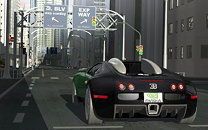- Joined
- Oct 9, 2007
- Messages
- 47,655 (7.44/day)
- Location
- Dublin, Ireland
| System Name | RBMK-1000 |
|---|---|
| Processor | AMD Ryzen 7 5700G |
| Motherboard | Gigabyte B550 AORUS Elite V2 |
| Cooling | DeepCool Gammax L240 V2 |
| Memory | 2x 16GB DDR4-3200 |
| Video Card(s) | Galax RTX 4070 Ti EX |
| Storage | Samsung 990 1TB |
| Display(s) | BenQ 1440p 60 Hz 27-inch |
| Case | Corsair Carbide 100R |
| Audio Device(s) | ASUS SupremeFX S1220A |
| Power Supply | Cooler Master MWE Gold 650W |
| Mouse | ASUS ROG Strix Impact |
| Keyboard | Gamdias Hermes E2 |
| Software | Windows 11 Pro |
Ray-tracing is the buzzword with consumer and professional graphics these days. It's a technique with which accurate representation of light with its behaviour in adherence with the laws of physics can be done when generating 3D computer graphics.
NVIDIA took ray-tracing to an interactive level with its work on an interactive real-time ray-tracing application. Currently NVIDIA has a larger stash of intellectual property in the field of ray-tracing than other players such as AMD or Intel, with the acquisition of MentalRay, a company that is pretty-much a standard in Hollywood.

At the Siggraph 2008 event, NVIDIA demonstrated a fully interactive GPU-based ray-tracer, which featured real-time ray-tracing in 30 frames/second (fps) and a resolution of 1920 x 1080 pixels. The demo saw NVIDIA flex its muscle with using almost every element in ray-tracing for which technology has been developed so far, namely a two-million polygon demo, an image-based paint shader, ray traced shadows, reflections and refractions.
To maintain those 30 fps at a high display resolution, NVIDIA used four Quadro FX 5800 graphics cards working in tandem. These next-gen Quadro boards are based on GT200(b) GPUs, come with 240 shader processors and 4 GB of GDDR3 memory (for a total of 960 shaders and 16 GB of GDDR3 memory).

View at TechPowerUp Main Site
NVIDIA took ray-tracing to an interactive level with its work on an interactive real-time ray-tracing application. Currently NVIDIA has a larger stash of intellectual property in the field of ray-tracing than other players such as AMD or Intel, with the acquisition of MentalRay, a company that is pretty-much a standard in Hollywood.

At the Siggraph 2008 event, NVIDIA demonstrated a fully interactive GPU-based ray-tracer, which featured real-time ray-tracing in 30 frames/second (fps) and a resolution of 1920 x 1080 pixels. The demo saw NVIDIA flex its muscle with using almost every element in ray-tracing for which technology has been developed so far, namely a two-million polygon demo, an image-based paint shader, ray traced shadows, reflections and refractions.
To maintain those 30 fps at a high display resolution, NVIDIA used four Quadro FX 5800 graphics cards working in tandem. These next-gen Quadro boards are based on GT200(b) GPUs, come with 240 shader processors and 4 GB of GDDR3 memory (for a total of 960 shaders and 16 GB of GDDR3 memory).

View at TechPowerUp Main Site





